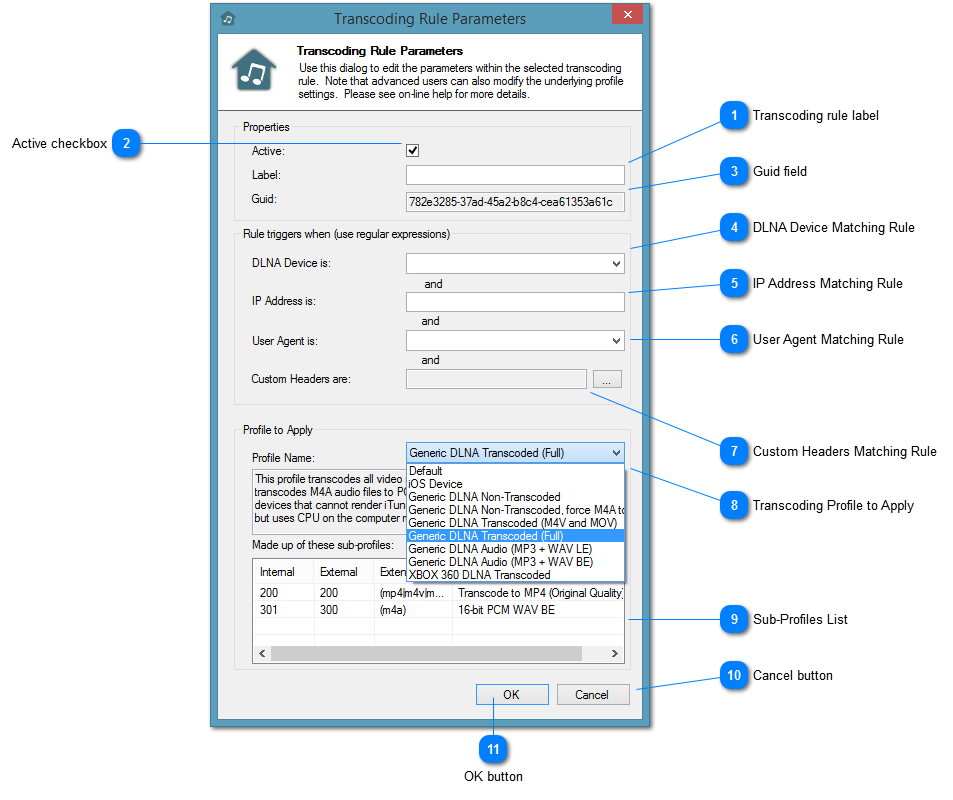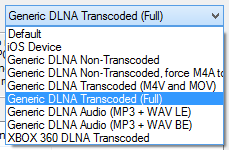Transcoding Rule Parameters window
 Transcoding rule label
Use this field to give the Transcoding Rule a friendly name so you can remember what it is used for.
|
|
 Active checkbox
This checkbox toggles whether the transcoding rule is active or inactive. If it is inactive, the rule will be ignored by iHomeServer when it is processing requests.
|
|
 Guid field
The Guid field is an internally generated unique identified for the rule. This field cannot be modified.
|
|
 DLNA Device Matching Rule
Note this field only applicable when defining a rule for a DLNA device. Use this field to specify that this Transcoding Rule should only fire if the streaming request comes from a client that advertises itself as a DLNA Renderer device whose friendly name matches this field value. Note the value of this field is a regular expression.
Therefore, for example, to fire a rule for all Sony Bravia televisions, the DLNA device field should be set to:
(BRAVIA)
Note that the drop down box will contain the names of any DLNA Renderer devices that have been advertised on your home network, therefore it is usually simplest just to pick the DLNA device from the drop down menu rather than work it out yourself.
This rule is combined with the other rules specified below using 'AND' logic. If you want to specify 'OR' logic, either specify it within the regular expression or create multiple rules.
|
|
 IP Address Matching Rule
Use this field to specify that this Transcoding Rule should only fire if the streaming request comes from a client with the provided IP address. Note the value of this field is a regular expression.
This rule is combined with the other rules specified below using 'AND' logic. If you want to specify 'OR' logic, either specify it within the regular expression or create multiple rules.
|
|
 User Agent Matching Rule
Use this field to specify that this Transcoding Rule should only fire if the streaming request comes from a client that includes the provided User Agent within its HTTP requests. Note the value of this field is a regular expression.
This rule is combined with the other rules specified below using 'AND' logic. If you want to specify 'OR' logic, either specify it within the regular expression or create multiple rules.
NB: note that, when used with a DLNA device, this rule only fires when thumbnail images or media files are requested from the device; therefore if your device does not request thumbnails before it requests media files this rule may not work reliably on the first request. Once iHomeServer has learnt the user agent for a given IP address, it will cache it for all future requests from the same IP address.
|
|
 Custom Headers Matching Rule
Use this field to specify that this Transcoding Rule should only fire if specific custom header name/value pairs are found in the HTTP requests that come from a client . Clicking the '...' button will open the following dialog allowing you to specify multiple name: value pairs. Note that the values are regular expressions:
NB: note that, when used for a DLNA device, this rule only fires when thumbnail images or media files are requested from the device; therefore if your device does not request thumbnails before it requests media files this rule may not work reliably on the first request.
|
|
 Transcoding Profile to Apply
The Transcoding Profile to Apply drop down allows you to select which transcoding profiles should be used when the conditions that have been created are met. The Transcoding Profile actually defines what transcoding takes place - i.e. which input file formats are transcoded to what output file formats. A set of these profiles are shipped with iHomeServer, however, advanced users can modify the existing profiles and add new profiles. Please see the section on Transcoding Profiles for further information. |
|
 Sub-Profiles List
The sub-profiles list shows which sub-profiles make up the profile you have selected to apply. Each item in the list maps an input file format (recognised by its file name extention) to a set of transcoding parameters. A default set of subprofiles are shipped with iHomeServer, however, advanced users can modify the existing subprofiles and add new subprofiles. Please see the section on Transcoding Profiles for further information. |
|
 Cancel button
This button closes the dialog without making further changes.
|
|
 OK button
This button commits the changes you have made and closes the dialog.
|
|


